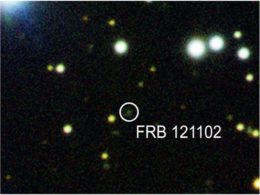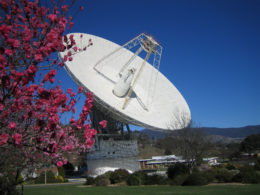Fast radio bursts are perplexing astrophysical phenomena. As their name suggests, they’re essentially short radio signals, but they pack a surprising amount of energy. More unusual is that some fast radio bursts repeat, while others are one-off events.
Repeating fast radio bursts present an opportunity to study bursts in more detail. So what do we see when we observe a burst at multiple frequencies simultaneously?

FRB 121102, the first fast radio burst found to repeat, was also the first to be localized in the sky. [Gemini Observatory/AURA/NSF/NRC]
A Tendency to Repeat Itself
Fast radio bursts (FRBs) typically last only a few milliseconds, but the strength with which they’re detected suggests that FRBs are produced by extremely energetic processes. What these processes are is an open question. Practically all known FRBs originated outside the Milky Way, though that might no longer be the case.
Some FRBs are known to repeat, allowing for their origin to be pinpointed far more accurately than one-off FRBs. The first known repeating FRB, called FRB 121102, lives in a dwarf galaxy over 2 billion light-years away. FRB 121102 has produced hundreds of bursts since its discovery, and studies have determined that it can be detected at multiple radio frequencies.
A new study led by Walid Majid (Jet Propulsion Laboratory/California Institute of Technology) revisited FRB 121102 using DSS-43, a 70-meter radio telescope in NASA’s Deep Space Network. The goal of this study was to probe FRB 121102’s bursts at higher frequencies than previously studied and to examine the bursts’ appearance in broadband observations.
Only One Right Frequency?
Broadband observations of FRBs provide spectra of the bursts, and spectra are extremely useful. In the case of FRBs, spectral features could either be caused by the mechanism of the burst itself, or they could instead have been added as the signal propagated through the host environment, across intergalactic space, and then through the Milky Way to reach us.
Majid and collaborators observed FRB 121102 with DSS-43 for nearly six hours on September 19, 2019. The observations were centered at 2.25 (S band) and 8.36 gigahertz (X band) with usable bandwidths of ~100 and ~430 megahertz respectively. Six bursts were observed in this time — but they were only seen in the lower-frequency S band!

The brightest burst observed from FRB 121102 as seen in the S band (bottom panel) and not seen in the X band (middle panel). The top panel shows the strength of the burst signal in the S band (black line) and the X band (grey line) as the signal-to-noise ratio versus time. In the middle and bottom panels, the signal is shown as frequency versus time, with dark areas corresponding to the burst. The time unit is milliseconds. [Adapted from Majid et al. 2020]
It All Depends on How You Look at It
The lack of a high-frequency detection for FRB 121102 is interesting, especially since the X band had a larger bandwidth than the S band. Does this frequency dependence provide insight into the FRB emission mechanism? Or does it only arise as the signal propagates to us?
Majid and collaborators explored the possibility that scintillation in our galaxy could be responsible for the lack of visible activity in the X band. In the context of FRBs, galactic scintillation is the observation of multiple bursts at various frequencies, caused by burst photons interacting with material in the Milky Way. The authors show that galactic scintillation can’t account for FRB 121102’s observations, suggesting the frequency dependence may have more to do with intrinsic properties of the emission mechanism or properties of the FRB’s host galaxy.
As with most things in astronomy, more observations are required. Wajid and collaborators concluded that dense, multi-frequency observations of FRB 121102 would go a long way to understanding its behavior. And so the mystery of FRBs continues!
Citation
“A Dual-band Radio Observation of FRB 121102 with the Deep Space Network and the Detection of Multiple Bursts,” Walid A. Majid et al 2020 ApJL 897 L4. doi:10.3847/2041-8213/ab9a4a



3 Comments
Pingback: From AAS NOVA: “Different Views of a Fast Radio Burst” | sciencesprings
Pingback: Różne spojrzenia na szybkie rozbłyski radiowe – PTMA Kraków
Pingback: Różne spojrzenia na szybkie rozbłyski radiowe – Astronomia Śląska